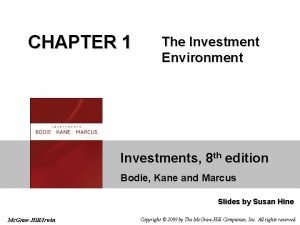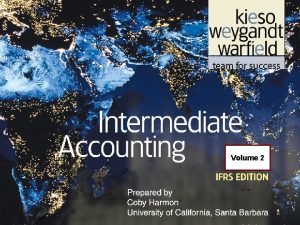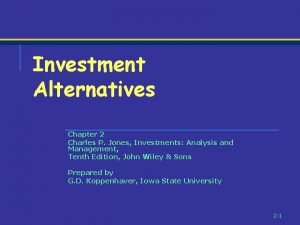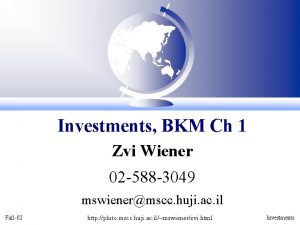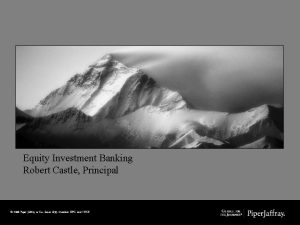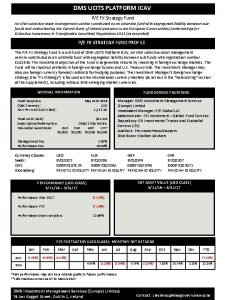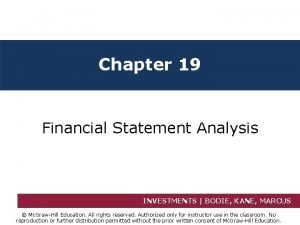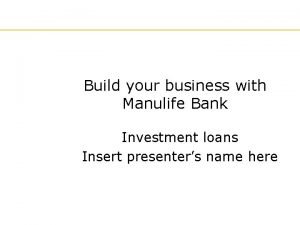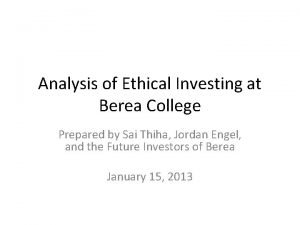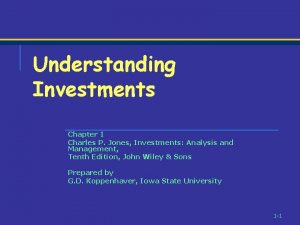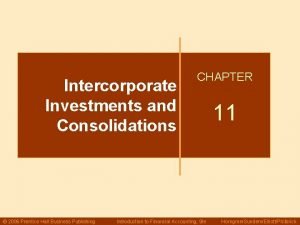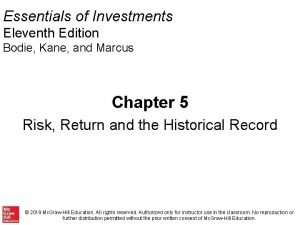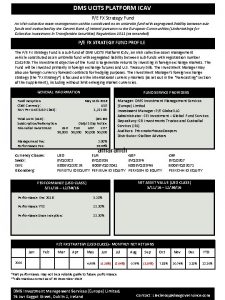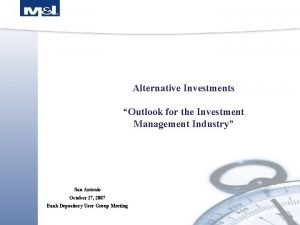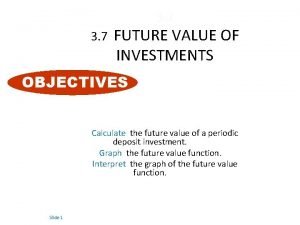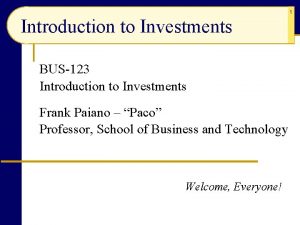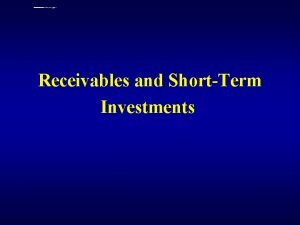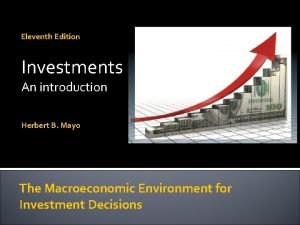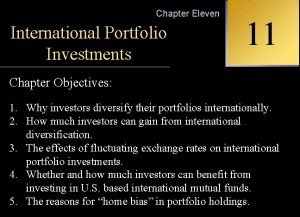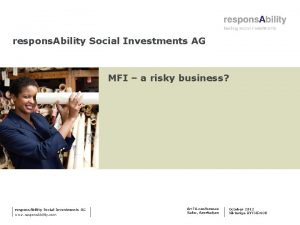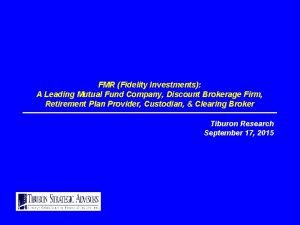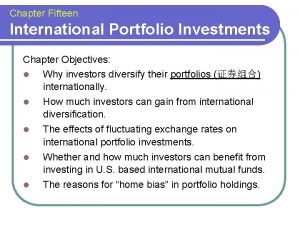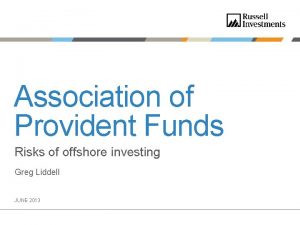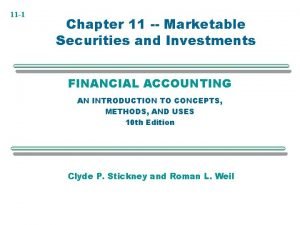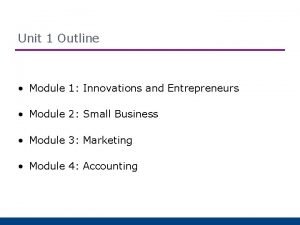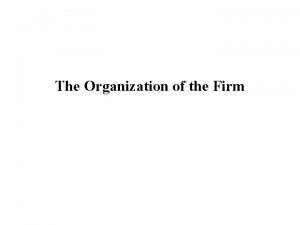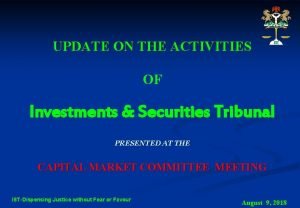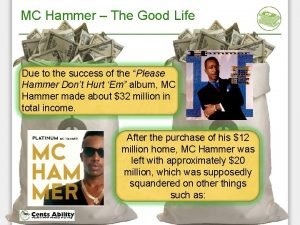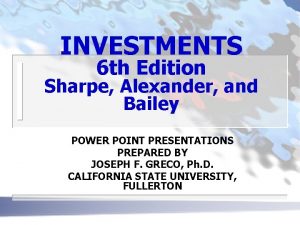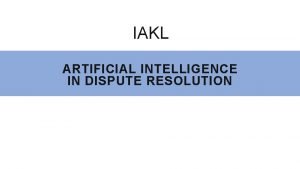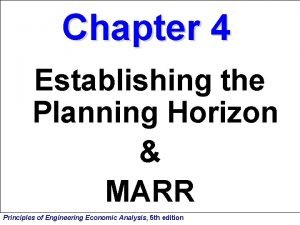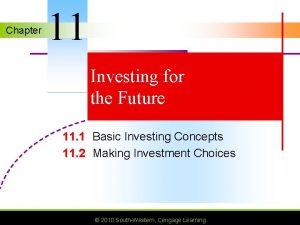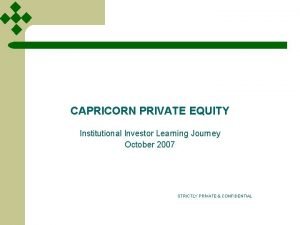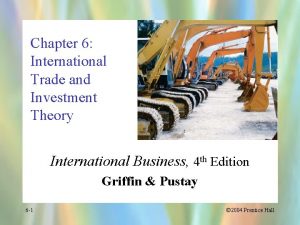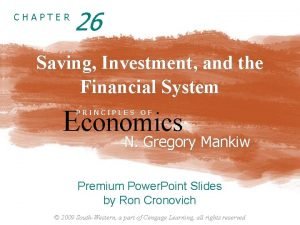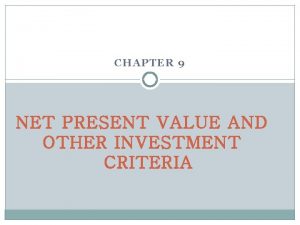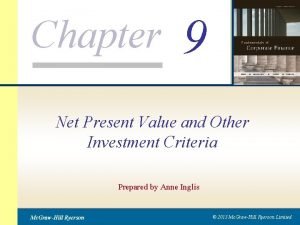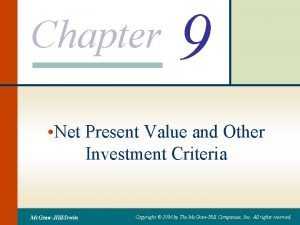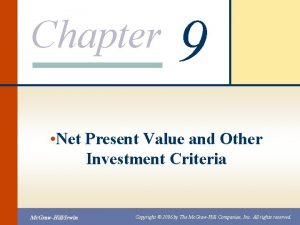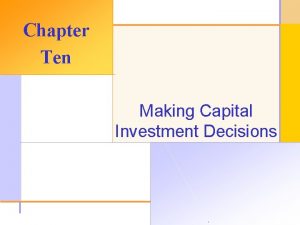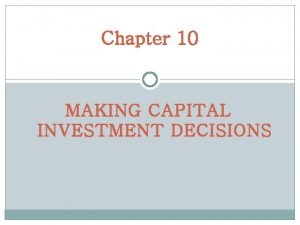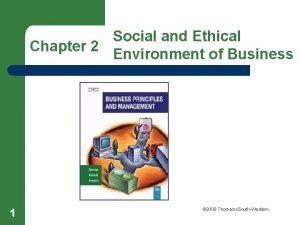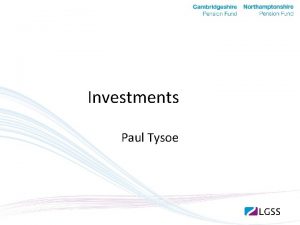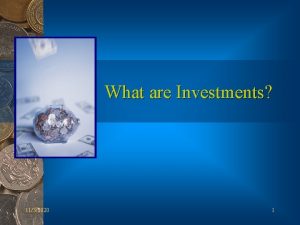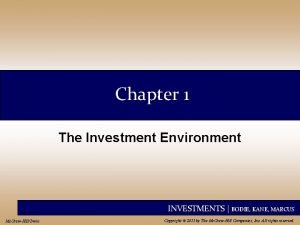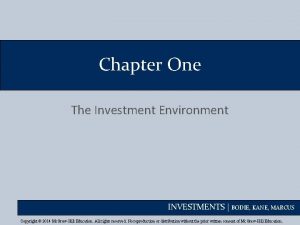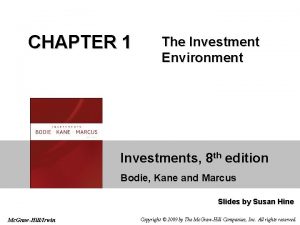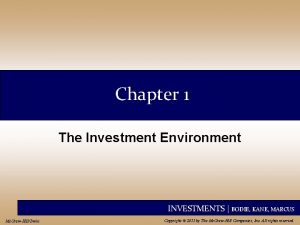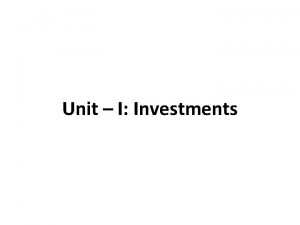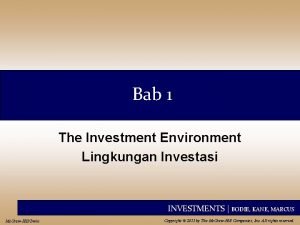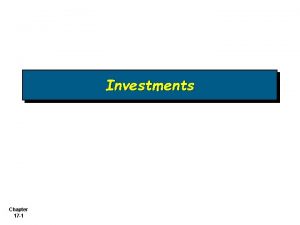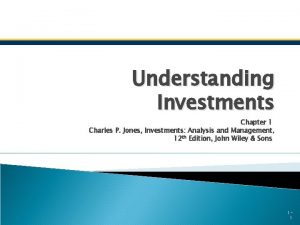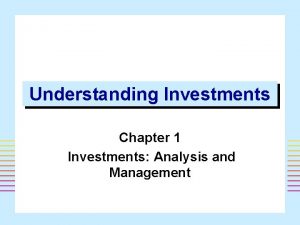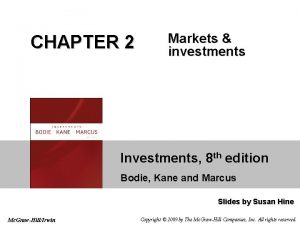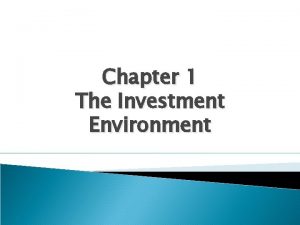CHAPTER 1 The Investment Environment Investments 8 th


















































































































- Slides: 114

CHAPTER 1 The Investment Environment Investments, 8 th edition Bodie, Kane and Marcus Slides by Susan Hine Mc. Graw-Hill/Irwin Copyright © 2009 by The Mc. Graw-Hill Companies, Inc. All rights reserved.

Real Assets Versus Financial Assets • Essential nature of investment – Reduced current consumption – Planned later consumption • Real Assets – Assets used to produce goods and services • Financial Assets – Claims on real assets 1 -2

Table 1. 1 Balance Sheet of U. S. Households, 2007 1 -3

Table 1. 2 Domestic Net Worth 1 -4

A Taxonomy of Financial Assets • Fixed income or debt – Money market instruments • Bank certificates of deposit – Capital market instruments • Bonds • Common stock or equity • Derivative securities 1 -5

Financial Markets and the Economy • Information Role – The Google effect • Consumption Timing • Allocation of Risk • Separation of Ownership and Management – Agency Issues 1 -6

Financial Markets and the Economy Continued • Corporate Governance and Corporate Ethics – Accounting Scandals • Examples – Enron, Rite Aid, Health. South – Auditors—watchdogs of the firms – Analyst Scandals • Arthur Andersen – Sarbanes-Oxley Act • Tighten the rules of corporate governance 1 -7

The Investment Process • Asset allocation – Choice among broad asset classes • Security selection – Choice of which securities to hold within asset class • Security analysis 1 -8

Markets are Competitive • Risk-Return Trade-Off • Efficient Markets – Active Management • Finding mispriced securities • Timing the market – Passive Management • No attempt to find undervalued securities • No attempt to time the market • Holding a highly diversified portfolio 1 -9

The Players • Business Firms– net borrowers • Households – net savers • Governments – can be both borrowers and savers • Financial Intermediaries – Investment Companies – Banks – Insurance companies – Credit unions 1 -10

The Players Continued • Investment Bankers – Perform specialized services for businesses – Markets in the primary market 1 -11

Table 1. 3 Balance Sheet of Commercial Banks, 2007 1 -12

Table 1. 4 Balance Sheet of Nonfinancial U. S. Business, 2007 1 -13

Recent Trends—Globalization • • American Depository Receipts (ADRs) Foreign securities offered in dollars Mutual funds that invest internationally Instruments and vehicles continue to develop (WEBs) • Exchange Traded Funds (ETFs) 1 -14

Figure 1. 1 Globalization: A Debt Issue Denominated in Euros 1 -15

Recent Trends—Securitization • Mortgage pass-through securities • Other pass-through arrangements – Car, student, home equity, credit card loans • Offers opportunities for investors and originators 1 -16

Figure 1. 2 Asset-backed Securities Outstanding 1 -17

Recent Trends—Financial Engineering • Use of mathematical models and computerbased trading technology to synthesize new financial products • Bundling and unbundling of cash flows 1 -18

Figure 1. 3 Building Creates a Complex Security 1 -19

Figure 1. 4 Unbundling of Mortgages into Principal- and Interest-Only Securities 1 -20

Recent Trends—Computer Networks • Online information dissemination • Information is made cheaply and widely available to the public • Automated trade crossing – Direct trading among investors 1 -21

CHAPTER 2 Asset Classes and Financial Instruments Investments, 8 th edition Bodie, Kane and Marcus Slides by Susan Hine Mc. Graw-Hill/Irwin Copyright © 2009 by The Mc. Graw-Hill Companies, Inc. All rights reserved.

Major Classes of Financial Assets or Securities • • • Money market Bond market Equity Securities Indexes Derivative markets 1 -23

The Money Market • Treasury bills – Bid and asked price – Bank discount method • Certificates of Deposits • Commercial Paper • Bankers Acceptances 1 -24

The Money Market Continued • Eurodollars • Repurchase Agreements (RPs) and Reverse RPs • Brokers’ Calls • Federal Funds • LIBOR Market 1 -25

Figure 2. 1 Rates on Money Market Securities 1 -26

Table 2. 1 Major Components of the Money Market 1 -27

Figure 2. 2 Treasury Bill Yields 1 -28

Figure 2. 3 The Spread between 3 -month CD and Treasury Bill Rates 1 -29

The Bond Market • • Treasury Notes and Bonds Inflation-Protected Treasury Bonds Federal Agency Debt International Bonds Municipal Bonds Corporate Bonds Mortgages and Mortgage-Backed Securities 1 -30

Treasury Notes and Bonds • Maturities – Notes – maturities up to 10 years – Bonds – maturities in excess of 10 years – 30 -year bond • Par Value - $1, 000 • Quotes – percentage of par 1 -31

Figure 2. 4 Lisiting of Treasury Issues 1 -32

Federal Agency Debt • Major issuers – Federal Home Loan Bank – Federal National Mortgage Association – Government National Mortgage Association – Federal Home Loan Mortgage Corporation 1 -33

Municipal Bonds • Issued by state and local governments • Types – General obligation bonds – Revenue bonds • Industrial revenue bonds • Maturities – range up to 30 years 1 -34

Figure 2. 5 Tax-exempt Debt Outstanding 1 -35

Municipal Bond Yields • Interest income on municipal bonds is not subject to federal and sometimes not to state and local tax • To compare yields on taxable securities a Taxable Equivalent Yield is constructed 1 -36

Table 2. 2 Equivalent Taxable Yields Corresponding to Various Tax-Exempt Yields 1 -37

Figure 2. 6 Ratio of Yields on Tax-Exempt to Taxable Bonds 1 -38

Corporate Bonds • Issued by private firms • Semi-annual interest payments • Subject to larger default risk than government securities • Options in corporate bonds – Callable – Convertible 1 -39

Mortgages and Mortgage-Backed Securities • Developed in the 1970 s to help liquidity of financial institutions • Proportional ownership of a pool or a specified obligation secured by a pool • Market has experienced very high rates of growth 1 -40

Figure 2. 7 Mortgage-backed Securities Outstanding, 1979 -2007 1 -41

Equity Securities • Common stock – Residual claim – Limited liability • Preferred stock – Fixed dividends -limited – Priority over common – Tax treatment • Depository receipts 1 -42

Figure 2. 8 Listing of Stocks Traded on the NYSE 1 -43

Stock Market Indexes • There are several broadly based indexes computed and published daily • There are several indexes of bond market performance • Others include: – Nikkei Average – Financial Times Index 1 -44

Dow Jones Industrial Average • Includes 30 large blue-chip corporations • Computed since 1896 • Price-weighted average 1 -45

Example 2. 2 Price-Weighted Average Portfolio: Initial value $25 + $100 = $125 Final value $30 + $ 90 = $120 Percentage change in portfolio value = 5/125 = -. 04 = -4% Index: Initial index value (25+100)/2 = 62. 5 Final index value (30 + 90)/2 = 60 Percentage change in index -2. 5/62. 5 = -. 04 = -4% 1 -46

Standard & Poor’s Indexes • Broadly based index of 500 firms • Market-value-weighted index • Index funds • Exchange Traded Funds (ETFs) 1 -47

Other U. S. Market-Value Indexes • NASDAQ Composite • NYSE Composite • Wilshire 5000 1 -48

Figure 2. 9 Comparative Performance of Several Stock Indexes, 2001 -2006 1 -49

Foreign and International Stock Market Indexes • Nikkei (Japan) • FTSE (Financial Times of London) • Dax (Germany) • MSCI (Morgan Stanley Capital International) • Hang Seng (Hong Kong) • TSX (Canada) 1 -50

Derivatives Markets Options • Basic Positions – Call (Buy) – Put (Sell) • Terms – Exercise Price – Expiration Date – Assets Futures • Basic Positions – Long (Buy) – Short (Sell) • Terms – Delivery Date – Assets 1 -51

Figure 2. 10 Trading Data on GE Options 1 -52

Figure 2. 11 Listing of Selected Futures Contracts 1 -53

CHAPTER 3 How Securities are Traded Investments, 8 th edition Bodie, Kane and Marcus Slides by Susan Hine Mc. Graw-Hill/Irwin Copyright © 2009 by The Mc. Graw-Hill Companies, Inc. All rights reserved.

How Firms Issue Securities • Primary – New issue – Key factor: issuer receives the proceeds from the sale • Secondary – Existing owner sells to another party – Issuing firm doesn’t receive proceeds and is not directly involved 1 -55

How Firms Issue Securities Continued • Investment Banking • Shelf Registration • Private Placements • Initial Public Offerings (IPOs) 1 -56

Investment Banking • Underwritten: firm commitment on proceeds to the issuing firm • Red herring • Prospectus 1 -57

Figure 3. 1 Relationship Among a Firm Issuing Securities, the Underwriters and the Public 1 -58

Shelf Registrations • SEC Rule 415 • Introduced in 1982 • Ready to be issued – on the shelf 1 -59

Private Placements • Sale to a limited number of sophisticated investors not requiring the protection of registration • Allowed under Rule 144 A • Dominated by institutions • Very active market for debt securities • Not active for stock offerings 1 -60

Initial Public Offerings • Process – Road shows – Bookbuilding • Underpricing – Post sale returns – Cost to the issuing firm 1 -61

Figure 3. 2 Average Initial Returns for IPOs in Various Countries 1 -62

Figure 3. 3 Long-term Relative Performance of Initial Public Offerings 1 -63

How Securities are Traded • Types of Markets – Direct search • Least organized – Brokered • Trading in a good is active – Dealer • Trading in a particular type of asset increases – Auction • Most integrated 1 -64

Types of Orders • Market—executed immediately – Bid Price – Ask Price • Price-contingent – Investors specify prices – Stop orders 1 -65

Figure 3. 4 The Limit Order Book for Intel on the Archipelago Market, January 19, 2007 1 -66

Figure 3. 5 Price-Contingent Orders 1 -67

Trading Mechanisms • Dealer markets • Electronic communication networks (ECNs) • Specialists markets 1 -68

U. S. Security Markets • Nasdaq and NYSE have evolved in response to new information technology • Both have increased their commitment to automated electronic trading 1 -69

Nasdaq • National Market System • Nasdaq Small Cap Market • Levels of subscribers – Level 1 – inside quotes – Level 2 – receives all quotes but they can’t enter quotes – Level 3 – dealers making markets 1 -70

Table 3. 1 Partial Requirements for Listing on NASDAQ Markets 1 -71

New York Stock Exchange • Member functions – Commission brokers – Floor brokers – Specialists • Block houses • Super. Dot 1 -72

Table 3. 2 Some Initial Listing Requirements for the NYSE 1 -73

Table 3. 3 Block Transactions on the New York Stock Exchange 1 -74

Other Systems • Electronic Communication Networks – Private computer networks that directly link buyers with sellers • National Market System – Securities Act of Amendments of 1975 • Bond Trading – Automated Bond System (ABS) 1 -75

Market Structure in Other Countries • London - predominately electronic trading • Euronext – market formed by combination of the Paris, Amsterdam and Brussels exchanges • Tokyo Stock Exchange • Globalization and consolidation of stock markets 1 -76

Figure 3. 6 Market Capitalization of Major World Stock Exchanges, 2007 1 -77

Trading Costs • Commission: fee paid to broker for making the transaction • Spread: cost of trading with dealer – Bid: price dealer will buy from you – Ask: price dealer will sell to you – Spread: ask - bid • Combination: on some trades both are paid 1 -78

Buying on Margin • Using only a portion of the proceeds for an investment • Borrow remaining component • Margin arrangements differ for stocks and futures 1 -79

Stock Margin Trading • Margin is currently 50%; you can borrow up to 50% of the stock value – Set by the Fed • Maintenance margin: minimum amount equity in trading can be before additional funds must be put into the account • Margin call: notification from broker that you must put up additional funds 1 -80

Margin Trading - Initial Conditions Example 3. 1 X Corp $100 60% Initial Margin 40% Maintenance Margin 100 Shares Purchased Initial Position Stock $10, 000 Borrowed Equity $4, 000 $6, 000 1 -81

Margin Trading - Maintenance Margin Example 3. 1 Stock price falls to $70 per share New Position Stock $7, 000 Borrowed $4, 000 Equity $3, 000 Margin% = $3, 000/$7, 000 = 43% 1 -82

Margin Trading - Margin Call Example 3. 2 How far can the stock price fall before a margin call? (100 P - $4, 000)* / 100 P = 30% P = $57. 14 * 100 P - Amt Borrowed = Equity 1 -83

Table 3. 4 Illustration of Buying Stock on Margin 1 -84

Short Sales • Purpose: to profit from a decline in the price of a stock or security • Mechanics – Borrow stock through a dealer – Sell it and deposit proceeds and margin in an account – Closing out the position: buy the stock and return to the party from which is was borrowed 1 -85

Short Sale – Initial Conditions Example 3. 3 Dot Bomb 50% 30% $100 1, 000 Shares Initial Margin Maintenance Margin Initial Price Sale Proceeds $100, 000 Margin & Equity 50, 000 Stock Owed 100, 000 1 -86

Short Sale - Maintenance Margin Stock Price Rises to $110 Sale Proceeds $10, 000 Initial Margin 5, 000 Stock Owed 11, 000 Net Equity 4, 000 Margin % (4000/11, 000) 36% 1 -87

Short Sale - Margin Call How much can the stock price rise before a margin call? ($150, 000* - 1000 P) / (100 P) = 30% P = $115. 38 * Initial margin plus sale proceeds 1 -88

Regulation of Securities Markets • Major regulations – Securities Act of 1933 – Securities Act of 1934 – Securities Investor Protection Act of 1970 • Self-Regulation – Stock markets are largely self-regulating 1 -89

Regulation Securities Markets Continued • Regulatory Responses to Recent Scandals – Public Company Accounting Oversight Board – Financial experts to serve on audit committees of boards of directors – CEOs and CFOs personally certify firms’ financial reports – Boards must have independent directors – Sarbanes-Oxley Act 1 -90

Circuit Breakers • Trading halts • Collars 1 -91

Insider Trading • Officers, directors, major stockholders must report all transactions in firm’s stock • Insiders do exploit their knowledge • Leakage of useful information to some traders 1 -92

CHAPTER 4 Mutual Funds and Other Investment Companies Investments, 8 th edition Bodie, Kane and Marcus Slides by Susan Hine Mc. Graw-Hill/Irwin Copyright © 2009 by The Mc. Graw-Hill Companies, Inc. All rights reserved.

Investment Companies • These companies perform several important functions for investors: – Administration & record keeping – Diversification & divisibility – Professional management – Reduced transaction costs 1 -94

Net Asset Value • Used as a basis for valuation of investment company shares – Selling new shares – Redeeming existing shares Calculation Market Value of Assets - Liabilities Shares Outstanding 1 -95

Types of Investment Companies • Unit Trusts • Managed Investment Companies – Open-End • Open-end: shares outstanding change when new shares are sold or old shares are redeemed • Priced at Net Asset Value(NAV) – Closed-End • no change in shares outstanding unless new stock is offered • Priced at Premium or discount to NAV 1 -96

Figure 4. 1 Closed-End Mutual Funds 1 -97

Types of Investment Companies Continued • Other investment organizations – Commingled funds – REITs – Hedge Funds 1 -98

Mutual Funds—Investment Policies • • Money Market Equity Sector Bond Balanced Asset Allocation and Flexible Index International 1 -99

Table 4. 1 U. S. Mutual Funds by Investment Classification 1 -100

How Funds Are Sold • Direct-marketed funds • Sales force distributed • Revenue sharing on sales force distributed – Potential conflicts of interest • Financial Supermarkets 1 -101

Costs of Investing in Mutual Funds • Fee Structure – Operating expenses – Front-end load – Back-end load – 12 b-1 charges • distribution costs paid by the fund • Alternative to a load 1 -102

Fees and Mutual Fund Returns 1 -103

Fees and Mutual Fund Returns: An Example Initial NAV = $20 Income distributions of $. 15 Capital gain distributions of $. 05 Ending NAV = $20. 10: 1 -104

Table 4. 2 Impacts of Costs on Investment Performance 1 -105

Trading Scandal with Mutual Funds • Late trading – allowing some investors to purchase or sell later than other investors • Market timing – allowing investors to buy or sell on stale net asset values – International • Net effect is to transfer value from other shareholders to privileged traders – Reduction in the rate of return of the mutual fund 1 -106

Potential Reforms • Strict 4: 00 PM cutoff with late orders executed the following trading day • Fair value pricing with net asset values being adjusted for trading in open markets • Imposition of redemption fees 1 -107

Taxation on Mutual Fund Income • Pass-through status under the U. S. tax code – Taxes are paid only by the investor • High turnover leads to tax inefficiency 1 -108

Exchange Traded Funds • ETF allow investors to trade index portfolios like shares of stock • Examples - SPDRs and WEBS • Potential advantages – Lower taxes – Trade continuously – Lower costs • Potential disadvantages – Prices can depart by small amounts from NAV 1 -109

Table 4. 3 EFT Sponsors and Products 1 -110

Mutual Fund Investment Performance: A First Look • Evidence shows that average mutual fund performance is generally less than broad market performance • Evidence that performance is consistent from one period to the next is suggestive but inconclusive 1 -111

Figure 4. 2 Diversified Equity Funds versus Wilshire 5000 Index 1 -112

Table 4. 4 Consistency of Investment Results 1 -113

Information on Mutual Funds • Wiesenberger’s Investment Companies • Morningstar (www. morningstar. com) • Yahoo (biz. yahoo. com/funds) • Investment Company Institute (www. ici. org) • Directory of Mutual Funds 1 -114
 Chapter 1 the investment environment
Chapter 1 the investment environment Chapter 1 the investment environment
Chapter 1 the investment environment Fixed investment and inventory investment
Fixed investment and inventory investment Intermediate accounting chapter 17
Intermediate accounting chapter 17 Intermediate accounting chapter 17 investments test bank
Intermediate accounting chapter 17 investments test bank Chapter 2 investments
Chapter 2 investments Chapter 11 real estate and other investments
Chapter 11 real estate and other investments Environment of business finance
Environment of business finance Equity method vs cost method
Equity method vs cost method Financial investment analysis
Financial investment analysis 02 588
02 588 Investments bodie kane marcus
Investments bodie kane marcus Loarre investments
Loarre investments Pe investments fx strategy
Pe investments fx strategy More power investments
More power investments Investments bodie kane marcus summary
Investments bodie kane marcus summary Holding a variety of investments to reduce risk
Holding a variety of investments to reduce risk Manulife rrsp loan
Manulife rrsp loan Investments berea
Investments berea Financial accounting chapter 6
Financial accounting chapter 6 Bus-123: introduction to investments
Bus-123: introduction to investments Understanding investments
Understanding investments Intercorporate investments
Intercorporate investments Intercorporate investments
Intercorporate investments Essentials of investments 11th edition
Essentials of investments 11th edition Strategie consulting dms
Strategie consulting dms Alternative investment outlook
Alternative investment outlook 3-7 future value of investments answers
3-7 future value of investments answers Bus-123: introduction to investments
Bus-123: introduction to investments Accounting for short term investments
Accounting for short term investments 3-7 future value of investments answers
3-7 future value of investments answers Eleventho de mayo
Eleventho de mayo Deca investments
Deca investments Bodie 50/50
Bodie 50/50 International portfolio investments
International portfolio investments Yale investments
Yale investments Responsability fair trade fund
Responsability fair trade fund Fmr asset management
Fmr asset management International portfolio analysis
International portfolio analysis James barber russell investments
James barber russell investments Green growth investments
Green growth investments What is marketable securities
What is marketable securities Alternative investments
Alternative investments Types of specialized investments
Types of specialized investments Investments background
Investments background Integrated territorial investments
Integrated territorial investments Investment and securities tribunal
Investment and securities tribunal Mc hammer net worth
Mc hammer net worth Bus-123: introduction to investments
Bus-123: introduction to investments Intercorporate
Intercorporate Integrated territorial investment
Integrated territorial investment Phyrrho investments it s an english predictive coding case
Phyrrho investments it s an english predictive coding case Interregional innovation investments
Interregional innovation investments For one-shot investments, the planning horizon is equal to
For one-shot investments, the planning horizon is equal to Chapter 11 investing for the future
Chapter 11 investing for the future Capricorn private equity
Capricorn private equity Hát kết hợp bộ gõ cơ thể
Hát kết hợp bộ gõ cơ thể Frameset trong html5
Frameset trong html5 Bổ thể
Bổ thể Tỉ lệ cơ thể trẻ em
Tỉ lệ cơ thể trẻ em Voi kéo gỗ như thế nào
Voi kéo gỗ như thế nào Thang điểm glasgow
Thang điểm glasgow Hát lên người ơi
Hát lên người ơi Môn thể thao bắt đầu bằng chữ đua
Môn thể thao bắt đầu bằng chữ đua Thế nào là hệ số cao nhất
Thế nào là hệ số cao nhất Các châu lục và đại dương trên thế giới
Các châu lục và đại dương trên thế giới Công thức tính độ biến thiên đông lượng
Công thức tính độ biến thiên đông lượng Trời xanh đây là của chúng ta thể thơ
Trời xanh đây là của chúng ta thể thơ Cách giải mật thư tọa độ
Cách giải mật thư tọa độ Phép trừ bù
Phép trừ bù độ dài liên kết
độ dài liên kết Các châu lục và đại dương trên thế giới
Các châu lục và đại dương trên thế giới Thể thơ truyền thống
Thể thơ truyền thống Quá trình desamine hóa có thể tạo ra
Quá trình desamine hóa có thể tạo ra Một số thể thơ truyền thống
Một số thể thơ truyền thống Cái miệng nó xinh thế chỉ nói điều hay thôi
Cái miệng nó xinh thế chỉ nói điều hay thôi Vẽ hình chiếu vuông góc của vật thể sau
Vẽ hình chiếu vuông góc của vật thể sau Biện pháp chống mỏi cơ
Biện pháp chống mỏi cơ đặc điểm cơ thể của người tối cổ
đặc điểm cơ thể của người tối cổ Giọng cùng tên là
Giọng cùng tên là Vẽ hình chiếu đứng bằng cạnh của vật thể
Vẽ hình chiếu đứng bằng cạnh của vật thể Tia chieu sa te
Tia chieu sa te Thẻ vin
Thẻ vin đại từ thay thế
đại từ thay thế điện thế nghỉ
điện thế nghỉ Tư thế ngồi viết
Tư thế ngồi viết Diễn thế sinh thái là
Diễn thế sinh thái là Dot
Dot Thế nào là số nguyên tố
Thế nào là số nguyên tố Tư thế ngồi viết
Tư thế ngồi viết Lời thề hippocrates
Lời thề hippocrates Thiếu nhi thế giới liên hoan
Thiếu nhi thế giới liên hoan ưu thế lai là gì
ưu thế lai là gì Sự nuôi và dạy con của hổ
Sự nuôi và dạy con của hổ Sự nuôi và dạy con của hổ
Sự nuôi và dạy con của hổ Sơ đồ cơ thể người
Sơ đồ cơ thể người Từ ngữ thể hiện lòng nhân hậu
Từ ngữ thể hiện lòng nhân hậu Thế nào là mạng điện lắp đặt kiểu nổi
Thế nào là mạng điện lắp đặt kiểu nổi Chapter 6 theories of international trade and investment
Chapter 6 theories of international trade and investment Mankiw chapter 26 solutions
Mankiw chapter 26 solutions Advantage and disadvantage of npv
Advantage and disadvantage of npv Net present value and other investment criteria
Net present value and other investment criteria Npv profiles
Npv profiles Chapter 9 net present value and other investment criteria
Chapter 9 net present value and other investment criteria Tax shield formula
Tax shield formula Afnan hossain
Afnan hossain Chapter 10 making capital investment decisions
Chapter 10 making capital investment decisions Chapter 4 managing in a global environment
Chapter 4 managing in a global environment Chapter 16 the marine environment
Chapter 16 the marine environment Chapter 1 hrm in a changing environment
Chapter 1 hrm in a changing environment Chapter 1 science and the environment answer key
Chapter 1 science and the environment answer key Chapter 1 science and the environment
Chapter 1 science and the environment Managing in a global environment chapter 4
Managing in a global environment chapter 4 Chapter 1 section 1 understanding our environment answers
Chapter 1 section 1 understanding our environment answers Chapter 2 social and ethical environment of business
Chapter 2 social and ethical environment of business

